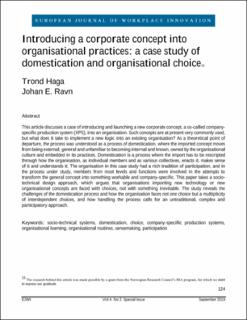| dc.contributor.author | Haga, Trond Sanne | |
| dc.contributor.author | Ravn, Johan Elvemo | |
| dc.date.accessioned | 2020-06-11T13:16:05Z | |
| dc.date.available | 2020-06-11T13:16:05Z | |
| dc.date.created | 2019-09-25T12:25:58Z | |
| dc.date.issued | 2019 | |
| dc.identifier.citation | Haga, T. & Ravn, J. E. (2019). Introducing a corporate concept into organisational practices: a case study of domestication and organisational choice. European Journal of Workplace Innovation, 4(2), 124-141. doi: | en_US |
| dc.identifier.issn | 2387-4570 | |
| dc.identifier.uri | https://hdl.handle.net/11250/2657733 | |
| dc.description.abstract | This article discusses a case of introducing and launching a new corporate concept, a so-called company-specific production system (XPS), into an organisation. Such concepts are at present very commonly used, but what does it take to implement a new logic into an existing organisation? As a theoretical point of departure, the process was understood as a process of domestication, where the imported concept moves from being external, general and unfamiliar to becoming internal and known, owned by the organisational culture and embedded in its practices. Domestication is a process where the import has to be rescripted through how the organisation, as individual members and as various collectives, enacts it, makes sense of it and understands it. The organisation in this case study had a rich tradition of participation, and in the process under study, members from most levels and functions were involved in the attempts to transform the general concept into something workable and company-specific. This paper takes a socio-technical design approach, which argues that organisations importing new technology or new organisational concepts are faced with choices, not with something inevitable. The study reveals the challenges of the domestication process and how the organisation faces not one choice but a multiplicity of interdependent choices, and how handling the process calls for an untraditional, complex and participatory approach. | en_US |
| dc.language.iso | eng | en_US |
| dc.publisher | University of Agder | en_US |
| dc.relation.uri | https://journal.uia.no/index.php/EJWI/article/view/571 | |
| dc.rights | Navngivelse 4.0 Internasjonal | * |
| dc.rights.uri | http://creativecommons.org/licenses/by/4.0/deed.no | * |
| dc.subject | Aksjonsforskning | en_US |
| dc.subject | Action research | en_US |
| dc.subject | Organisasjon og ledelse | en_US |
| dc.subject | Leadership and organizational theory | en_US |
| dc.subject | Arbeidsorganisering | en_US |
| dc.subject | Arbeidsorganisering | en_US |
| dc.subject | Organisasjonsutvikling | en_US |
| dc.subject | Organisation development | en_US |
| dc.title | Introducing a corporate concept into organisational practices: a case study of domestication and organisational choice | en_US |
| dc.type | Peer reviewed | en_US |
| dc.type | Journal article | en_US |
| dc.description.version | publishedVersion | en_US |
| dc.rights.holder | © 2019 The Author(s) | en_US |
| dc.subject.nsi | VDP::Offentlig og privat administrasjon: 242 | en_US |
| dc.subject.nsi | VDP::Public and private administration: 242 | en_US |
| dc.source.pagenumber | 124-141 | en_US |
| dc.source.volume | 4 | en_US |
| dc.source.journal | European Journal of Workplace Innovation | en_US |
| dc.source.issue | 2 | en_US |
| dc.identifier.doi | 10.46364/ejwi.v4i2.571 | |
| dc.identifier.cristin | 1728829 | |
| dc.relation.project | The Research Council of Norway: 256754 | en_US |

